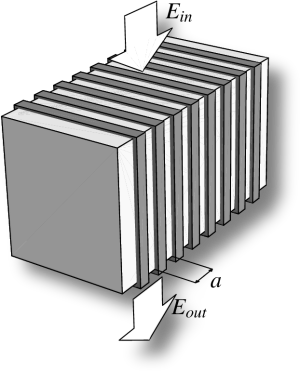Strongly nonlinear phenomena in semiconductor superlattices
Mar 10, 2011, Jukka Isohätälä - jisohata@student.oulu.fi

Strongly nonlinear phenomena in semiconductor superlatticesMar 10, 2011, Jukka Isohätälä - jisohata@student.oulu.fi |
 |

Fig. 1. Schematic view of a superlattice |
Semiconductor superlatticesSemiconductor superlattices (SSLs), Fig. 1, are sometimes mentioned as being model systems for nonlinear transport. The nonlinearity of these nanostructures stems from the out of the ordinary current response to an external voltage -- characterized by a current-voltage curve featuring a tail showing pronounced negative differential conductivity, Fig. 2. We study the dynamics of ballistic miniband electrons using the superlattice balance equation approach. These equations describe the balance between the acceleration and heating caused by the electric field inside the superlattice, and the scattering that dampens them. Albeit the model requires for some simplifications, it is accepted that it describes the system sufficiently well to quantitatively predict phenomena occuring in these systems. |
||
|
By considering feedback effects, an additional source of nonlinearity is introduced. When we account for displacements currents inside the superlattice, the electric field inside the superlattice is no longer uniquely given by the applied field. Instead, the motion of the electrons couples to the net electric field, making the current and field mutually dependent. This dependence is what finally causes the strongly nonlinear effects present in these systems. These effects include the spontaneous generation of dc-bias in a pure-ac driven system, and dissipative chaos. The starting point for the model is the Boltzmann Transport equation, and the semiclassical equations of motion. With some simplifying assumptions, equations governing the time evolution of the (here scaled) distribution averaged electron velocity, v, and energy w, both in the superlattice axis direction. Using an effective cicuit model or Maxwell's equations, the net electric field u can be derived.
Currently, we are studying the strength of a spontaneously genereted electric field, using realistic superlattice parameters. Furthermore, we wish to probe the stability of the spatially homogeneous electron distribution. |
 Fig. 2. Esaki-Tsu --type current-voltage characteristic. |
[1] J. Isohätälä and K. N. Alekseev, Rectification of terahertz radiation in semiconductor superlattices in the absence of domains, J. Phys. Condens. Mat. 24, 145303 (2012).
[2] J. Isohätälä and K. N. Alekseev, Devil's staircase, chaos and rectification via quasiperiodic plasma oscillations in semiconductor superlattices, e-print 1201.6280.
[3] J. Isohätälä, Stability properties of periodically driven overdamped pendula and their implications to physics of semiconductor superlattices and Josephson junctions, Chaos 20, 023116 (2010), e-print 0911.1215.
[4] J. Isohätälä, K. N. Alekseev, L. T. Kurki and P. Pietiläinen, Symmetry breaking in driven and strongly damped pendulum, Phys. Rev. E 71, 066206 (2005), e-print cond-mat/0409572.
[5] K. N. Alekseev, P. Pietiläinen, J. Isohätälä, A. A. Zharov and F. V. Kusmartsev, Chaos and rectification of electromagnetic wave in a lateral semiconductor superlattice, Europhys. Lett. 70, 292 (2005), e-print cond-mat/0111454.
| [6] J. Isohätälä, Plasma instability in semiconductor superlattices: Quasiperiodic oscillations, Devil's staircase, and chaos. Talk and poster at Joint International Workshop on "A new generation of ultra-sensitive detectors for dark energy and cosmology experiments", 2008 Mar 30 - Apr 06: Workshop in Bjorkliden, Kiruna, Sweden |

|
| [7] J. Isohätälä and K. N. Alekseev, Chaos and rectification in lateral semiconductor superlattices, Poster presentation at International Summer School and Conference on Arrays of Quantum Dots and Josephson Junctions, AQDJJ network of European Science Foundation, June 9th - 24th 2005, Kiten, Bulgaria |

|
| [8] J. Isohätälä, K. N. Alekseev and P. Pietiläinen, Symmetry breaking in the pendulum limit of semiconductor superlattice balance equation model, Poster presentation at Workshop on Arrays of Quantum Dots and Josephson Junctions, AQDJJ network of European Science Foundation, 21st - 27th October 2004, Split, Croatia. |

|